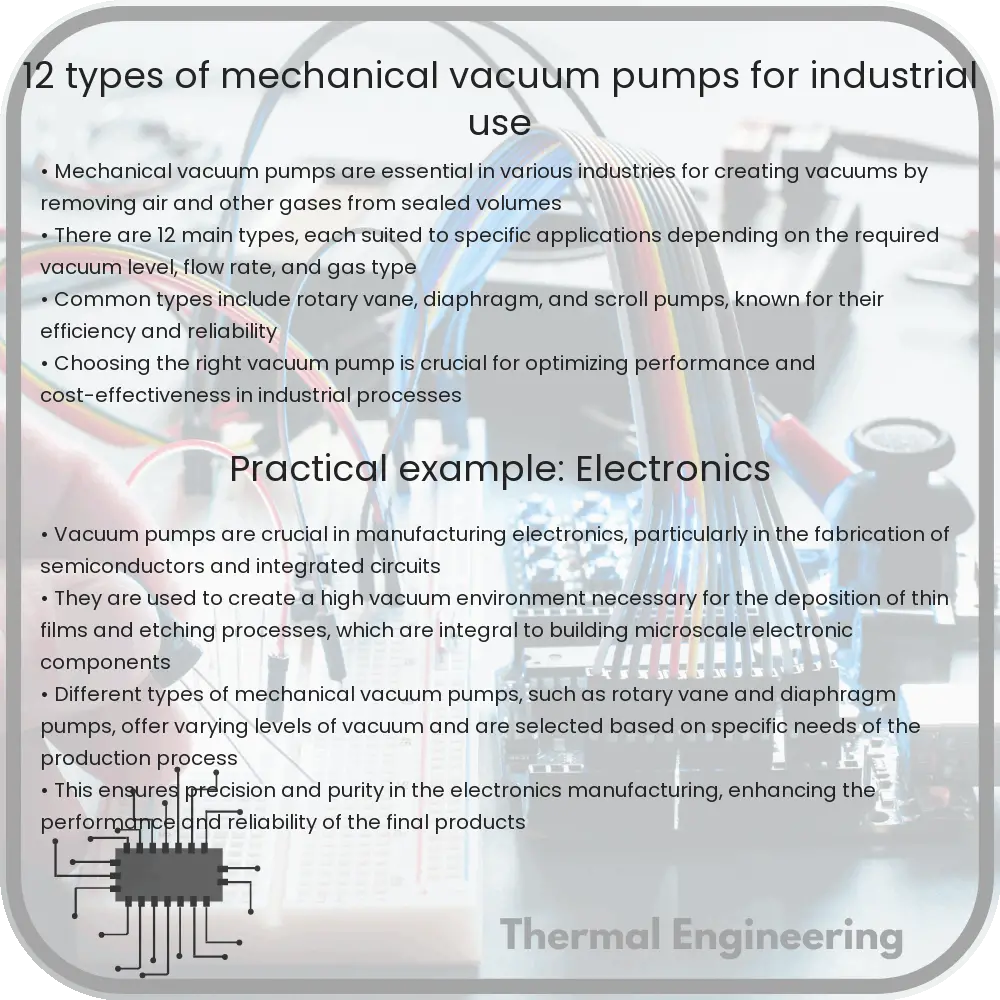Explore 12 common types of mechanical vacuum pumps used in various industrial applications, detailing their mechanisms and benefits.

12 Types of Mechanical Vacuum Pumps for Industrial Use
Vacuum pumps are an essential component in various industrial processes. These devices create, improve, and maintain vacuum in an enclosed space. Different types of vacuum pumps are used depending on the required vacuum quality, volumetric flow rate, and nature of the application. Here, we explore 12 common types of mechanical vacuum pumps used in industrial settings.
1. Positive Displacement Pumps
Positive displacement pumps repeatedly expand a cavity, allowing gases to flow in from the chamber, seal off the cavity, and exhaust it to the atmosphere. Common types include:
- Rotary Vane Pump: This pump consists of a rotor with longitudinal vanes sliding in slots which rotate inside a cavity. As the rotor turns, the vanes create sealed chambers that compress and move the gas towards the outlet.
- Liquid Ring Pump: A ring of liquid acts as a piston to achieve compression. This type of pump is praised for its simplicity and reliability in handling wet gases.
- Diaphragm Pump: Uses a diaphragm that moves up and down to create a vacuum. Ideal for clean, dry, and relatively low-capacity applications.
2. Momentum Transfer Pumps
Momentum transfer pumps, also known as molecular pumps, use high-speed jets of dense fluid or high-speed rotating blades to knock gas molecules out of the chamber. They include:
- Turbomolecular Pump: Utilizes a series of angled blades that rotate at high speeds to effectively push gas molecules out of the pump.
- Diffusion Pump: Utilizes jets of oil or mercury vapor to capture and drive gas molecules from the vacuum side to the exhaust side.
3. Regenerative Pumps
Also known as side channel pumps, these create a vacuum by regenerating air molecules through a multi-blade impeller’s rotation at high speeds.
- Regenerative Blower: Often used when moderate vacuum is sufficient, and where contamination from oil or other substances must be avoided.
4. Entrapment Pumps
These pumps capture gas molecules on a surface within the vacuum system via processes like sorption and condensation. They are typically used for creating ultra-high vacuums.
- Cryopumps: Utilize extremely cold temperatures to condense gases into a solid or liquid state, trapping them.
- Getter Pumps: Use reactive materials that chemically bind or adsorb gases.
- Ion Pumps: Use a high magnetic field to ionize gas molecules and capture them on a solid surface.
5. Scroll Pumps
Scroll pumps feature two interleaved spiral-shaped scrolls, where one is fixed and the other moves in small orbits, progressively compressing the gas pockets.
6. Screw Pumps
Screw pumps use two meshed screws that rotate to move and compress gases from the inlet to the outlet side of the pump.
7. Wankel Pumps
This is a type of rotary pump where a rotor in the shape of a symmetric lobe rotates within an oval cavity.
8. Lobe Pumps
Lobe pumps are similar to rotary pumps but use lobed rotors instead of vanes to move the gas. Used in applications requiring high flow rates.
9. Claw Pumps
Claw pumps operate with two claw-shaped rotors rotating in opposite directions to compress the gas. They are robust and operate dry, without the need for oil sealing or lubrication.
10. Roots Blower (Roots Pump)
Also known as a rotary lobe pump, it is widely used for mid-range vacuum level applications. It operates by pumping fluid with a pair of meshing lobes against a chamber wall.
11. Piston Pump
Utilizes a piston moving backward and forward in a cylinder to compress and move gas. It’s suitable for applications requiring high-pressure ratios.
12. Gear Pumps
These use the meshing of gears to pump fluid by displacement and are more commonly used for hydraulic fluid applications but can be designed for high vacuum environments.
Each vacuum pump type offers different characteristics making them suitable for various industrial applications, from manufacturing and processing to research and development. Understanding the operational mechanics and advantages of each can significantly improve selection and application in specific industrial processes.